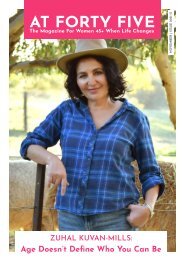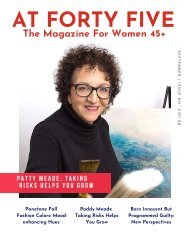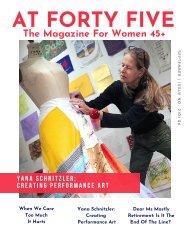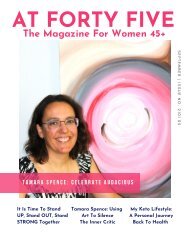The Art Of Tammy Bailey AT FORTY FIVE Magazine Issue R 2021 12
A magazine for women 45+ who want to own aging with spirit and joy. For those of us rediscovering who we are & exploring what we want next. We want more; health, wealth, happiness, & fulfillment. Join women around the world navigating the best years yet.
A magazine for women 45+ who want to own aging with spirit and joy. For those of us rediscovering who we are & exploring what we want next. We want more; health, wealth, happiness, & fulfillment. Join women around the world navigating the best years yet.
Create successful ePaper yourself
Turn your PDF publications into a flip-book with our unique Google optimized e-Paper software.
<strong>AT</strong> <strong>FORTY</strong> <strong>FIVE</strong> MAGAZINE /15<br />
We learn how to hate just the same way we<br />
learn how to love. While love is our natural<br />
state, our environment and external<br />
programming determine how we deal with<br />
our negative emotions as well as our capacity<br />
to love.<br />
Nelson Mandela said, "No one is born hating<br />
another person because of the color of his skin,<br />
or his background, or his religion. People must<br />
learn to hate, and if they can learn to hate, they<br />
can be taught to love, for love comes more<br />
naturally to the human heart than its<br />
opposite."<br />
Anger, resentment, rage, and hatred are blocks<br />
to love. Negative emotions come with a lot of<br />
judgment or a fear of judgment. Many people<br />
do not know how to process these heavy<br />
negative emotions. Even those who have fits of<br />
rage and outwardly express hate are doing so<br />
because that is part of their learned<br />
programming, but also because they don’t<br />
know how to process their own negative<br />
emotions in a healthy way.<br />
Before I explain how we can process this<br />
long-held accumulation of negative<br />
emotions, I would like to explain the idea of<br />
healthy and unhealthy expressions of<br />
anger. When I was a child, I was taught that<br />
anger was bad—to be angry was to be<br />
violent. While I never experienced any<br />
physical violence in my own home, I grew<br />
to believe that anger equaled violence. My<br />
interpretation of that falsehood was that<br />
anger was unacceptable and shouldn’t be<br />
outwardly expressed. I learned to hold it in<br />
and bury it deep inside. I learned to bite my<br />
tongue and swallow that bitter pill of<br />
resentment.<br />
<strong>The</strong>se heavy emotions are becoming harder to<br />
hide, contain within, and keep at bay. It is as<br />
though a bubbling volcano is ready to erupt. In<br />
fact, many people process anger that way.<br />
Unexpressed anger becomes a cesspool of<br />
resentment, which eventually becomes a bout<br />
of rage. Eventually, the volcano needs to erupt.<br />
When something happens in our environment<br />
that bumps up against our accumulated<br />
boiling cesspool of unexpressed feelings, it<br />
causes us to blow up. Instead of feeling our<br />
own unexpressed feelings, we project them<br />
out into the world and cast our anger out as<br />
words and/or violence.<br />
"Unexpressed anger becomes a<br />
cesspool of resentment, which<br />
eventually becomes a bout of<br />
rage."















